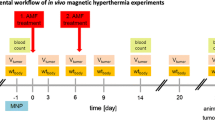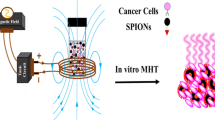Abstracts
Studies demonstrating the successful and safe application of magnetic hyperthermia in large animals are scarce. A therapeutic approach for advanced cancer comprising multicore encapsulated iron oxide (IO) Sarah Nanoparticles (SaNPs), that uniquely self-regulate their temperature, was developed thus overcoming the safety challenges of hyperthermia. SaNPs are intravenously injected and accumulate in tumor tissue, leading to selective heating upon exposure to an external alternating magnetic field (AMF). A series of studies were conducted in healthy swine to assess SaNPs’ safety, alone or combined with AMF application. Administration of single high (up to 22 mg IO/kg) or low (3.6 mg IO/kg) SaNP doses had no adverse effects, including no infusion reactions. Vital signs remained stable with no significant clinical pathology changes, and no treatment-associated toxicities. Biodistribution analysis indicated that SaNPs predominantly accumulate in the lungs and clear in a dose- and time-dependent manner. In minipigs that received a single SaNP no-observed-adverse-effect-level (NOAEL)-based dose (3.6 mg IO/kg) with AMF, the average percentage remaining in vital organs after 90 days was 13.7%. No noticeable clinical signs were noted during the 87 to 92-day observation period following irradiation, and no inflammation, necrosis, nor thermal damage were found in the histopathology evaluation. In another minipig, ~ 90 days after three recurrent high doses (14 mg IO/kg), without AMF, almost half of the injected SaNPs were cleared with no residual detrimental effects. We demonstrate that the approach is safe and well tolerated in swine, opening potential avenues as a novel therapeutic modality for cancer patients.







Similar content being viewed by others
References
Albl B, Haesner S, Braun-Reichhart C, Streckel E, Renner S, Seeliger F, Wolf E, Wanke R, Blutke A (2016) Tissue sampling guides for porcine medical models. Toxicol Pathol 44(3):414–420. https://doi.org/10.1177/0192623316631023
Arami H, Khandhar A, Liggitt D, Krishnan KM (2015) In vivo delivery, pharmacokinetics, biodistribution and toxicity of iron oxide nanoparticles. Chem Soc Rev 44(23):8576–8607. https://doi.org/10.1039/c5cs00541h
Baetke SC, Lammers T, Kiessling F (2015) Applications of nanoparticles for diagnosis and therapy of cancer. Br J Radiol 88(1054):20150207. https://doi.org/10.1259/bjr.20150207
Cohen-Erner M, Khandadash R, Hof R, Shalev O, Antebi A, Cyjon A, Nyska A, Goss G, Hilton J, Peer D (2021) Fe3O4 nanoparticles and paraffin wax as phase change materials embedded in polymer matrixes for temperature-controlled magnetic hyperthermia. ACS Appl Nanomaterials. https://doi.org/10.1021/acsanm.1c02676
Csukás D, Urbanics R, Wéber G, Rosivall L, Szebeni J (2015) Pulmonary intravascular macrophages: prime suspects as cellular mediators of porcine CARPA. Eur J Nanomed 7(1):27–36. https://doi.org/10.1515/ejnm-2015-0008
Dixit R, Boelsterli UA (2007) Healthy animals and animal models of human disease(s) in safety assessment of human pharmaceuticals, including therapeutic antibodies. Drug Discov Today 12(7–8):336–342. https://doi.org/10.1016/j.drudis.2007.02.018
Edge D, Shortt CM, Gobbo OL, Teughels S, Prina-Mello A, Volkov Y, MacEneaney P, Radomski MW, Markos F (2016) Pharmacokinetics and bio-distribution of novel super paramagnetic iron oxide nanoparticles (SPIONs) in the anaesthetized pig. Clin Exp Pharmacol Physiol 43(3):319–326. https://doi.org/10.1111/1440-1681.12533
Ekdahl KN, Persson B, Mohlin C, Sandholm K, Skattum L, Nilsson B (2018) Interpretation of serological complement biomarkers in disease. Front Immunol 9:2237. https://doi.org/10.3389/fimmu.2018.02237
Feng Q, Liu Y, Huang J, Chen K, Huang J, Xiao K (2018) Uptake, distribution, clearance, and toxicity of iron oxide nanoparticles with different sizes and coatings. Sci Rep 8(1):2082. https://doi.org/10.1038/s41598-018-19628-z
Forget P, Khalifa C, Defour JP, Latinne D, Van Pel MC, De Kock M (2017) What is the normal value of the neutrophil-to-lymphocyte ratio? BMC Res Notes 10(1):12. https://doi.org/10.1186/s13104-016-2335-5
Frank JA, Kalish H, Jordan EK, Anderson SA, Pawelczyk E, Arbab AS (2007) Color transformation and fluorescence Prussian blue-positive cells: Implications for histologic verification of cells labeled with superparamagnetic iron oxide nanoparticles. Mol Imaging 6(3):212–218
Gneveckow U, Jordan A, Scholz R, Brüss V, Waldöfner N, Ricke J, Feussner A, Hildebrandt B, Rau B, Wust P (2004) Description and characterization of the novel hyperthermia- and thermoablation- system MFH®300F for clinical magnetic fluid hyperthermia. Med Phys 31(6):1444–1451. https://doi.org/10.1118/1.1748629
Gobbo OL, Wetterling F, Vaes P, Teughels S, Markos F, Edge D, Shortt CM, Crosbie-Staunton K, Radomski MW, Volkov Y, Prina-Mello A (2015) Biodistribution and pharmacokinetic studies of SPION using particle electron paramagnetic resonance, MRI and ICP-MS. Nanomedicine (lond) 10(11):1751–1760. https://doi.org/10.2217/nnm.15.22
Hergt R, Dutz S (2007) Magnetic particle hyperthermia – Biophysical limitations of a visionary tumor therapy. J Mag Mag Mater 311:187–192. https://doi.org/10.1016/j.jmmm.2006.10.1156
Ho JC, Nguyen L, Law JJ, Ware MJ, Keshishian V, Lara NC, Nguyen T, Curley SA, Corr SJ (2017) Non-invasive radiofrequency field treatment to produce hepatic hyperthermia: Efficacy and safety in swine. IEEE J Transl Eng Health Med 5:1500109. https://doi.org/10.1109/JTEHM.2017.2672965
Ivkov R, DeNardo SJ, Daum W, Foreman AR, Goldstein RC, Nemkov VS, DeNardo GL (2005) Application of high amplitude alternating magnetic fields for heat induction of nanoparticles localized in cancer. Clin Cancer Res 11(19 Pt 2):7093s–7103s. https://doi.org/10.1158/1078-0432.CCR-1004-0016
Jain TK, Reddy MK, Morales MA, Leslie-Pelecky DL, Labhasetwar V (2008) Biodistribution, clearance, and biocompatibility of iron oxide magnetic nanoparticles in rats. Mol Pharm 5(2):316–327. https://doi.org/10.1021/mp7001285
Johannsen M, Thiesen B, Wust P, Jordan A (2010) Magnetic nanoparticle hyperthermia for prostate cancer. Int J Hyperthermia 26(8):790–795. https://doi.org/10.3109/02656731003745740
Kerlin R, Bolon B, Burkhardt J et al (2016) Scientific and regulatory policy committee: Recommended (“best”) practices for determining, communicating, and using adverse effect data from nonclinical studies. Toxicol Pathol 44(2):147–162. https://doi.org/10.1177/0192623315623265
Klein R, Nagy O, Tóthová C, Chovanová F (2020) Clinical and diagnostic significance of lactate dehydrogenase and its isoenzymes in animals. Vet Med Int 2020:5346483. https://doi.org/10.1155/2020/5346483
Kraus S, Khandadash R, Hof R, Nyska A, Sigalov E, Eltanani M, Rukenstein P, Rabinovitz R, Kassem R, Antebi A, Shalev O, Cohen-Erner M, Goss G, Cyjon A (2021) Novel nanoparticle-based cancer treatment, effectively inhibits lung metastases and improves survival in a murine breast cancer model. Front Oncol 11:761045. https://doi.org/10.3389/fonc.2021.761045
La-Beck NM, Islam MdR, Markiewski MM (2021) Nanoparticle-induced complement activation: Implications for cancer nanomedicine. Front Immunol 11:603039. https://doi.org/10.3389/fimmu.2020.603039
Maier-Hauff K, Rothe R, Scholz R, Gneveckow U, Wust P, Thiesen B, Feussner A, von Deimling A, Waldoefner N, Felix R, Jordan A (2007) Intracranial thermotherapy using magnetic nanoparticles combined with external beam radiotherapy: Results of a feasibility study on patients with glioblastoma multiforme. J Neurooncol 81:53–60. https://doi.org/10.1007/s11060-006-9195-0
Moghimi SM, Simberg D (2017) Complement activation turnover on surfaces of nanoparticles. Nano Today 15:8–10. https://doi.org/10.1016/j.nantod.2017.03.001
Nadobny J, Klopfleisch R, Brinker G, Stoltenburg-Didinger G (2015) Experimental investigation and histopathological identification of acute thermal damage in skeletal porcine muscle in relation to whole-body SAR, maximum temperature, and CEM43°C due to RF irradiation in an MR body coil of birdcage type at 123 MHz. Int J Hyperthermia 31(4):409–420. https://doi.org/10.3109/02656736.2015
Nurgali K, Jagoe RT, Abalo R (2018) Editorial: Adverse effects of cancer chemotherapy: anything new to improve tolerance and reduce sequelae? Front Pharmacol 9:245. https://doi.org/10.3389/fphar.2018.00245
Palazzi X, Burkhardt JE, Caplain H, Dellarco V, Fant P, Foster JR, Francke A, Paul Germann S, Gröters S, Harada T, Harleman J, Inui K, Kaufmann W, Lenz B, Nagai H, Pohlmeyer-Esch G, Schulte A, Skydsgaard M, Tomlinson L, Wood CE, Yoshida M (2016) Characterizing “adversity” of pathology findings in nonclinical toxicity studies: Results from the 4th ESTP International Expert Workshop. Toxicol Pathol 44(6):810–824. https://doi.org/10.1177/0192623316642527
Redondo E, Masot AJ, Fernández A, Gázquez A (2009) Histopathological and immunohistochemical findings in the lungs of pigs infected experimentally with Mycoplasma hyopneumoniae. J Comp Pathol 140(4):260–270. https://doi.org/10.1016/j.jcpa.2008.12.008
Rinke M (1997) How clean is a mini-pig? – Impressions and suggestions of a pathologist working in the field of toxicology. Pharmacol Toxicol 80(Suppl 2):16–22. https://doi.org/10.1111/j.1600-0773.1997.tb01983.x
Schafer KA, Eighmy J, Fikes JD, Halpern WG, Hukkanen RR, Long GG, Meseck EK, Patrick DJ, Thibodeau MS, Wood CE, Francke S (2018) Use of severity grades to characterize histopathologic changes. Toxicol Pathol 46(3):256–265. https://doi.org/10.1177/0192623318761348
Sharma A, Tyagi VV, Chen CR, Buddhi D (2009) Review on thermal energy storage with phase change materials and applications. Renew Sustain Energ Rev 13:318–345. https://doi.org/10.1016/j.rser.2007.10.005
Siegel RL, Miller KD, Fuchs HE (2021) Jemal A (2021) Cancer statistics. CA Cancer J Clin 71(1):7–33. https://doi.org/10.3322/caac.21654
Silva AV, Ringblom J, Moldeus P, Törnqvist E, Öberg M (2021) Benchmark dose-response analyses for multiple endpoints in drug safety evaluation. Toxicol Appl Pharmacol. https://doi.org/10.1016/j.taap.2021.115732
Stull CL, Kachulis CJ, Farley JL, Koenig GJ (1999) The effect of age and teat order on alpha1-acid glycoprotein, neutrophil-to-lymphocyte ratio, cortisol, and average daily gain in commercial growing pigs. J Anim Sci 77(1):70–74. https://doi.org/10.2527/1999.77170x
Swindle MM, Makin A, Herron AJ, Clubb FJ Jr, Frazier KS (2012) Swine as models in biomedical research and toxicology testing. Veterinary Pathol 49(2):344–356. https://doi.org/10.1177/0300985811402846
Szebeni J, Bedőcs P, László D, Urbanics R (2018) A porcine model of complement activation-related pseudoallergy to nano-pharmaceuticals: Pros and cons of translation to a preclinical safety test. Prec Nanomed 1(1):63–73. https://doi.org/10.29016/180427.1
Tansi FL, Maduabuchi WO, Hirsch M, Southern P, Hattersley S, Quaas R, Teichgräber U, Pankhurst QA, Hilger I (2021) Deep-tissue localization of magnetic field hyperthermia using pulse sequencing. Int J Hyperthermia 38(1):743–754. https://doi.org/10.1080/02656736.2021.1912412
Thiesen B, Jordan A (2008) Clinical applications of magnetic nanoparticles for hyperthermia. Int J Hyperth 24(6):467–474. https://doi.org/10.1080/02656730802104757
Thompson JS, Brown SA, Khurdayan V, Zeynalzadedan A, Sullivan PG, Scheff SW (2002) Early effects of tribromoethanol, ketamine/xylazine, pentobarbitol, and isoflurane anesthesia on hepatic and lymphoid tissue in ICR mice. Comp Med 52(1):63–67
Tvedten H, Raskin RE (2012) Leukocyte disorders. Small Animal Clin Diagnosis Laboratory Methods. https://doi.org/10.1016/B978-1-4377-0657-4.00004-1
US FDA (2005) Guidance for industry: Estimating the maximum safe starting dose in initial clinical trials for therapeutics in adult healthy volunteers. Rockville, MD: US Food and Drug Administration
Urbanics R, Bedőcs P, Szebeni J (2015) Lessons learned from the porcine CARPA model: constant and variable responses to different nanomedicines and administration protocols. Eur J Nanomed 7(3):219–231. https://doi.org/10.1515/ejnm-2015-0011
Wang R, Song B, Wu J, Zhang Y, Chen A, Shao L (2018) Potential adverse effects of nanoparticles on the reproductive system. Int J Nanomedicine 13:8487–8506. https://doi.org/10.2147/IJN.S170723
Wust P, Gneveckow U, Johannsen M, Böhmer D, Henkel T, Kahmann F, Sehouli J, Felix R, Ricke J, Jordan A (2006) Magnetic nanoparticles for interstitial thermotherapy – feasibility, tolerance and achieved temperatures. Int J Hyperthermia 22(8):673–685. https://doi.org/10.1080/02656730601106037
Acknowledgements
The authors thank Dr Jennifer Fleming, Dr Lynn Lucke, Ms Tal Alon, and Mr Doron Suchi for their valuable comments and fruitful discussions during the studies.
Funding
This work was supported by New Phase Ltd.
Author information
Authors and Affiliations
Contributions
Conceptualization: SK, OS. Methodology: SK, RK, PR, MC-E. Formal analysis and investigation: SK, RR, ES, ME, ES, AN, YS-T. Writing – original draft preparation: SK, RR. Writing – review and editing: SK, CT, OR, ES, OS. Funding acquisition: OS. Resources: OS. Supervision: SK, OS.
Corresponding author
Ethics declarations
Conflict of interest
The authors declare the following competing interests: S. Kraus, R. Rabinovitz, E. Sigalov, M. Eltanani, R. Khandadash, C. Tal, O. Rivlin, E. Sharaga, P. Rukenstein, M. Cohen-Erner, O. Shalev are employees at New Phase Ltd. Other authors declare no competing interests.
Additional information
Publisher's Note
Springer Nature remains neutral with regard to jurisdictional claims in published maps and institutional affiliations.
Rights and permissions
About this article
Cite this article
Kraus, S., Rabinovitz, R., Sigalov, E. et al. Self-regulating novel iron oxide nanoparticle-based magnetic hyperthermia in swine: biocompatibility, biodistribution, and safety assessments. Arch Toxicol 96, 2447–2464 (2022). https://doi.org/10.1007/s00204-022-03314-1
Received:
Accepted:
Published:
Issue Date:
DOI: https://doi.org/10.1007/s00204-022-03314-1




